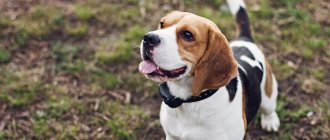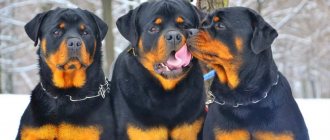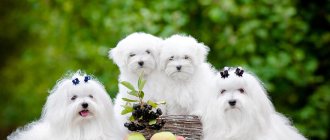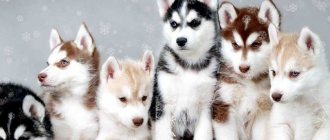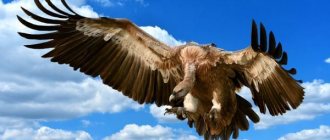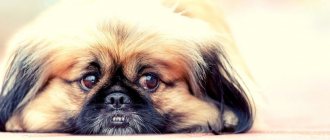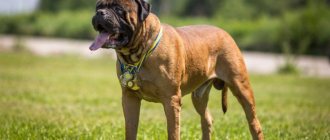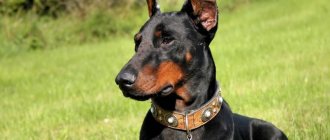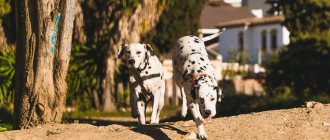One of the rarest and most mysterious breeds is the Pekingese.
During its existence, the color of the Pekingese's coat has undergone many changes.
This is one of the few breeds today where almost any color is allowed as a standard.
Pekingese disqualifying colors are liver and albino..
The red Pekingese is the most popular and common coat.
This color also includes light red, red and golden. in the pedigree . It is customary to write the main color in the “color” column – red.
The next most common color is fawn . Shades range from milky to dark walnut tones. Fawn dogs often have a black mask.
White wool is characterized by milky and creamy shades. But white dogs must have dark noses and rims around the eyes and lips.
Black and white Pekingese are less fluffy, although these dogs look very entertaining. The coloring is quite rare, since due to the smaller volume of wool, nursery owners prefer to breed more “dressed” representatives of the breed.
Gradually, black and white Pekingese and white and red representatives are conquering the market.
History of the origin of the breed
Several years ago, American dog handlers became concerned about the origins of the Pekingese. They took DNA from the dogs, examined it and came to interesting conclusions. The animal has common roots with the wolf. The owners of the breed did not like the relationship; they liked the beautiful legend about the origin of the little pets much more.
Legend No. 1
Many, many years ago, a formidable and beautiful lion fell in love with a monkey. Agile and pretty, dressed in a white fur coat, she impressed the king of beasts. The situation in animal society was not conducive to the unification of loving hearts. The lion is the king of the fauna, the monkey is comparable to a simple peasant woman, what kind of union can we talk about?
Then the lion rejected his great height, crown and throne in order to unite with his beloved. From such an unusual union, a Pekingese dog was born, which inherited luxurious fur from its father, and facial expression and color from its mother.
Legend No. 2
The second story, concerning the origin of the Pekingese, is filled with sad events. The Royal Pekingese has been known for more than 2000 years, its homeland is China, and Empress Tsu-Khi had a hand in breeding representatives of the breed, who wrote its first standard in the 19th century. Until the middle of the declared century, nothing was known about the Pekingese dog breed outside of China. The year 1860 came, England and France defeated Beijing, the emperor with his family and servants were forced to flee. Only his elderly aunt remained in the summer palace, who considered it beneath her dignity to run away from enemies. Along with the woman there were five Pekingese dogs, two males and three females.
The further story has two branches. According to some sources, the invaders who broke into the palace found the aunt dead; she took her own life, but did not have time to kill the dogs. The second version tells that the elderly woman was unable to commit suicide. Her further fate is unknown, and the royal Pekingese ended up in the hands of marauders. The animals were taken to England, these dogs became the founders of the breed.
36 years later, in 1896, two more dogs were brought to the UK. According to one version, animals took an active part in the formation of the modern type of breed. However, comparing photos of the old-type Pekingese and the current one, this hypothesis raises serious doubts.
At the end of the 19th century, the Royal Pekingese ended up in the USA, where the dog was appreciated. Breeding work began, in which the Japanese Chin was involved. To this day, all breeders in the world focus on English Pekingese, trying to get a show animal.
Breed in Russia
According to official data, the Pekingese breed appeared in Russia in the 50s of the 20th century. However, there is a hypothesis that the miniature dog was popular among the highest nobility under Nicholas II. His daughter Anastasia was given an animal named Jemmy. According to unverified information, Jemmy was shot along with his owner.
Interesting fact! To this day, only rich people keep Pekingese in China. The tax on a representative of this breed is very high.
Varieties: Chinese, royal, imperial (photos)
On message boards you can often see similar publications: “Imperial Pekingese puppies”, “real Chinese Pekingese”, “Royal Pekingese” - all this is nothing more than a publicity stunt.
If we talk about purebred and standard, then there are no varieties of Pekingese.
NOTE!
The terms “royal” and “imperial” were coined at the peak of the breed’s popularity to attract buyers eager to receive a status pet.
However, they really got a dog “like the emperor,” because he also had an ordinary Pekingese.
Also, many people confuse Japanese Chins with Pekingese, believing that these are two varieties of the same breed. It's not like that at all. They differ in everything - from external parameters to character traits.
Be sure to pay attention to this when choosing a pet.
Varieties and description of the Pekingese breed
Types of Pekingese are divided into:
- Pekingese;
- standard or royal Pekingese;
- The sleeve Pekingese stands out in particular.
The first category includes old-type dogs, which are very different from modern representatives of the breed. About 100 years ago, more graceful Pekingese were bred, taller than today, with a long body. Today, old-type dogs are extremely rare, they do not meet the standard, and participation in exhibitions and breeding is prohibited.
The smallest Pekingese is called the Sleeve. According to a beautiful legend, representatives of the Chinese imperial family carried tiny dogs in their sleeves. The sleeves of clothes were wide, the wind often blew in the palaces, and small dogs served as living protection from the cold.
Modern sleeve dogs are rarely born, because females do not take part in breeding. They are too small, natural birth ends in death, veterinary intervention can end the same way. It is enough to exceed the dose of sleeping pills in order to put the animal to sleep during a cesarean section, and the pet will never wake up.
Sleeve males are bred to standard females; the probability of giving birth to a tiny Pekingese is very low. These dogs cost incredible amounts of money and differ in size from the royal representative of the breed.
The weight of sleeve Pekingese does not exceed 3 kg , in all other respects they are the same as standard dogs.
Royal Pekingese standard
The description of the Royal Pekingese, according to the FCI standard from 2009, looks like this:
- General appearance: a small dog with an intelligent expression of the muzzle, stocky. A strong sense of self-esteem and superiority is expressed.
- Head: large, wide. The skull is voluminous, flat between the ears and wide.
- The muzzle is short, wide, and clearly visible.
- The eyes are round, medium in size, dark in color.
- The nose is short and wide, the nostrils are large and open. A light fold stretches from the cheekbones to the bridge of the nose, representing an inverted “V”.
- The lips are dense and should not hide a pronounced chin. The teeth and tongue are not visible behind the lips.
- The ears are heart-shaped, located at the level of the top line of the skull, reaching the bottom line of the muzzle, but not descending beyond it. Fit tightly to the head.
- The neck is thick and short.
- The body is short, the waist is clearly defined.
- The chest is wide, the ribs are well sprung.
- The front legs are wide and flat, sometimes turned slightly outward.
- The hind legs are strong and well developed.
- The tail is set high and is often carried over the back or side.
Size and weight
According to the breed standard, the ideal weight of the Royal Pekingese is 5.5 kg .
- The minimum weight for a male dog is 5.3 kg, the maximum is 6 kg.
- The minimum weight of a female is 4.8 kg, the maximum is 5.7 kg.
- The height of the male is 19-23 cm.
- The height of the female is from 18 to 21 cm.
Color and coat type
The Pekingese coat description is as follows:
Long, straight. A collar is formed around the neck, which should not extend beyond the shoulder blades. The undercoat of dogs is dense and soft, the outer coat appears rough. There are feathers on the ears, hind legs and tail. The fur should not interfere with the movement of the animal; its excessive length is considered a defect.
The Imperial Pekingese comes in numerous colors. The most common are red and fawn representatives of the breed.
The main colors are presented in the list:
- Red is divided into several options: light red, golden, red. Having a dog of red color, for example, the owner will receive a pedigree for it, in the color column it is indicated “red”. You need to know that the color subtype is not specified in the pedigree, only red.
- Today, dogs with a gray color are becoming popular. They look great. Gray color can vary from fawn to dark silver.
- Pekingese dogs are very beautiful and have a milky color.
- There are representatives of the breed that are black and white.
- Paticolor is a fairly common occurrence among Pekingese. The dog is painted white and red.
- Black and tan color is very rare. Its carriers are short-haired Pekingese; such dogs are born extremely rarely in the kennel.
- The Black Pekingese is another rare representative of the breed. Often puppies are born with white markings on the forehead and paws, this is not a defect.
- If a buyer is offered a white Pekingese with blue eyes, he should run away from such a breeder. They want to sell an albino to a naive person, passing him off as a purebred dog. Albinos are considered a breeding match, a true white Pekingese has dark eyes, black eyeliner around them and a pigmented nose.
IMPORTANT! If a breeder heavily praises a small puppy, passing it off as a dwarf Pekingese, you should run away. The buyer is faced with a typical breeder, because breeders know that the name “dwarf” is not used in relation to the breed.
Characteristic
Dogs have special features and the first is the eyes of the Pekingese. This is the most painful place. By structure, they have a bulging shape with a bare upper eyelid, therefore they are not protected from six and dust and require specific care.
The head is large in comparison with the overall size. In this case, the width of the skull is greater than the length. The frontal part is wide. The muzzle is short and in structure resembles a bulldog shape.
The lips are black in color, the lower one completely hides the tongue and teeth, which are small and tightly set. The nose is only black.
The ears are small and covered with hair. The neck is short. The body is rectangular in shape. The chest part is voluminous with sloping ribs. The groin is tightened. The tail is of medium thickness when raised.
The hind and front legs are stable with good joints. The hind legs with developed thigh muscles are lighter than the front legs. Shoulders and elbows are parallel and directed back. The wrists of the front paws are at a slight angle to the surface, and the hands of the hind paws are straight.
A prerequisite is the presence of a lush mane up to the shoulders and backcombing on the paws, tail and ears, which should not hide the structure of the silhouette. The fur is thick and can be of any color.
- The most popular dog names in alphabetical order with recommendations
Shar Pei - history of the breed, character traits, care and possible problems + 87 photos
American Bulldog - history of the breed, appearance, specifics and characteristics, care (100 photos + video)
Health and illness
When purchasing a representative of the breed, you should be prepared for regular visits to the veterinarian, because the dogs are quite painful. Those dreaming of a puppy are presented with a list of possible diseases:
- Cataracts, in which the lens of the eye changes. The changes lead to clouding of the eye or blindness.
- Distichiasis or abnormal eyelash growth.
- Turning of the eyelid outward.
- Turning of the eyelid inward.
- Dermatitis of the muzzle that occurs in its folds.
- Hemolytic anemia or destruction of red blood cells.
- Hypoplasia of the tooth. With this disease, there is no development of part of the second vertebra, which leads to its mobility.
- Hypothyroidism is an endocrine disease leading to the destruction of the thyroid gland.
- Disease of the intervertebral discs, they become prone to ruptures and displacements.
- Inguinal hernia.
- Keratitis, characterized by a lack of tears in one or both eyes.
- Atresia of the tear streams, in which they are too small or not formed at all.
- Displacement of the lens, characterized by its incorrect position.
- Microphthalmia. With this condition, one or both eyes are too small.
- Pannus is the growth of tissue above the cornea of the eyes.
- Inflammation of the cornea in which the pigmentation is abnormal is called pigmentary keratitis.
- Retinal atrophy.
- Skull too short.
- Ulcerative keratitis, accompanied by the formation of ulcers on the cornea.
- Thrombocytopenia, in which the platelet count in the blood is low. This leads to hemorrhages in the mucous membranes.
Lifespan
When thinking about purchasing a puppy, the potential owner wonders how long do Pekingese live? The lifespan of a representative of the breed varies from 12 to 15 years .
IMPORTANT! The imperial dog is quite sickly. Treatment is very expensive and not always effective.
Main types of colors
The following types of colors for Pekingese are recognized as standard::
- Ginger . Varies from red to golden shades.
- Fawn . From milky to nutty. The muzzle is outlined with a black mask.
- Black . Looks very attractive. Most often used at exhibitions.
- Black and Tan . Tan markings are superimposed on a black background. Dogs of this color come with or without masks.
- Black and white . Individuals with this color are distinguished by shorter fur.
- White . Pekingese is the only dog breed in which full albinos are likely to appear. Albinism is a disqualifying feature, but is highly valued among lovers of “exotics.”
With any of the above colors, a small white spot on the forehead is acceptable . In ancient China, it was believed that such a mark made the dog a lucky talisman for its owner and called it “the kiss of Buddha.”
Colors such as grey, brown (liver), red, light fawn and spotted are also possible . However, such individuals are not allowed for further breeding and exhibitions.
Character and intelligence
When purchasing a charming baby, it is worth remembering its original purpose and luxurious life in the palaces of the Chinese imperial family. The little dogs had personal chefs, hairdressers and teachers; to date, representatives of the breed have retained their royal dignity.
The kids are smart, devoted to their owner and somewhat stubborn. To win the favor of a Pekingese, whose characteristics tell of his excessive sense of his own superiority, you will have to make an effort. Effort does not mean physical impact on the dog, but the owner’s immense patience. The Pekingese requires a respectful attitude towards its person; you can negotiate with the dog and explain it to it, but a representative of the breed will ignore orders.
Attitude towards children and others
A monkey dog is walking down the street, people are touched by the charming dog, children reach out to stroke it. The Pekingese looks kind and calm, but it categorically cannot tolerate a familiar attitude towards itself.
A little secret: a decent breeder will not sell his “graduate” to a family with children under six years of age. Kids try to express feelings towards the animal by lifting it by its front paws, sharply tugging on its fur, or trying to put a finger in its mouth. The puppy has not yet learned to resist; such treatment will make him physically and mentally disabled. An adult dog is patient with children, she is unlikely to bite a little bully, but being a nanny is beneath her dignity.
The dog is lenient towards strangers; if they try to pet the Pekingese and demonstrate their friendly attitude, he will accept the affection. At the same time, the dog will look truly royal; with his facial expression, the representative of the breed says “so be it, pet me.”
Prefers to be the only pet in the family and has a hard time getting along with burrowing dogs. The latter turn the Pekingese into a neurasthenic - hysterical.
IMPORTANT! The animal is not suitable for families with small children.
Buy a Pekingese
If such a desire arises, then it is better to buy a 2-month-old puppy, while maintaining his usual diet. It is not recommended to purchase Pekingese through an advertisement, in passages or at the Bird Market, since this breed is considered an aristocratic one. The best option is to go to a trusted breeder or a special breed nursery.
A number of characteristic deficiencies can be observed in females and males, but males have the most favorable prospects. Females show excessive attention to members of the opposite sex every six months. In fact, this process does not negatively affect the pet, but during walks you should avoid moments when the female meets the male. To make life easier for yourself and the dog, it is better to sterilize the female after her first heat, which has a positive effect on her appearance.
What to pay attention to
First of all, you should decide why you need a puppy of this breed - to participate in exhibition shows, for breeding work or as a pet. When visually examining the puppy, you should determine how active and healthy it is, and whether its exterior meets breed standards. It is very important that the puppy has all the accompanying documents confirming the purebred of the puppy, as well as the presence of all necessary vaccinations.
Price of a purebred puppy
Prices may depend on exterior features, which may pave the way for the pet to be shown. Naturally, for such a prospect you will have to pay an additional price. Puppies that can just become pets cost about 20 thousand rubles maximum, and more promising ones cost an order of magnitude more.
Training and education
A dog, regardless of its breed and size, must know basic commands. The imperial dog is no exception to the rule; you can train your baby at home.
It all starts with adopting a nickname. Keeping in mind the stubbornness of the small Pekingese dog, education and training is based on positive reinforcements. The dog has completed the task - it is rewarded with something tasty and praised.
Famous owners
There is information that after the sinking of the famous Titanic, only two dogs survived. One of them was a Pekingese named Sun-Yang-Sen, whose owner was Henry Sleeper. The dog was taken into the boat along with other passengers.
Bishop of the Russian Orthodox Church Alexei II lived with a Pekingese named Pusha. Famous owners of representatives of this breed also included:
- Marilyn Monroe;
- Elizabeth Taylor;
- Joan Rivers.
Pros and cons of the breed
According to the characteristics of the breed, the Pekingese has a tiny body, but the heart of a lion. In first place among his positive qualities is his courage.
- There are several types of Pekingese, as described above. All of them are fearless, capable of rushing into battle, protecting the owner from a two-legged enemy or a large dog. Owners say that their pets have long forgotten about their own size.
- The Pekingese, who once lived in the palaces of the Chinese emperor, remembers his roots. Our ancestors had an amazing sense of self-esteem, and today's dogs have preserved and increased it. This means that the baby will begin to behave as if he is the owner. The animal will not run after the owner, begging for attention and affection, but will favorably accept the manifestation of his feelings towards himself.
- When walking, he prefers the company of his owner; escapes are a rare occurrence among Pekingese.
Disadvantages of the breed:
- Predisposition to numerous diseases.
- Cold attitude towards children and pets.
- Fancy in care and maintenance.
- High cost of a show class puppy.
What do boys and girls look like? Main differences
Unlike most breeds, the females of the Pekingese are larger than the males . Males weigh up to 5 kg, while females can weigh 500-800 grams heavier.
Breeders often give preference to boys due to their more pronounced breed qualities . Their fur coat is richer, the color is more interesting, and molting occurs only twice a year in the off-season. They participate in exhibitions more often than females.
The girls look more modest - instead of a chic mane, they have a fluffy collar. Shedding occurs not only in the off-season, but also during estrus and after childbirth.
If you have children, give preference to a female Pekingese . Thanks to her natural maternal instinct, she tolerates increased attention from children more calmly.
Dog diet
Your pet needs a balanced and high-quality diet - natural food or dry food.
List of permitted products:
- Lean meat, boiled. Preferably veal or turkey, beef is too tough, chicken is an allergenic product.
- Occasionally they give rice and oatmeal; excessive consumption of carbohydrates will lead to weight problems.
- Vegetables, excluding potatoes and corn.
- Dairy products: low-fat cottage cheese and kefir, natural yogurt, homemade cheese are the favorite delicacies of the Pekingese breed, whose origins began with imperial dogs. They ate gourmet meals prepared by a personal chef. Current representatives of the breed have to be content with ordinary food.
- Once a week, a boiled quail egg is allowed.
- The menu must include a vitamin complex and fish oil.
Feeding natural food does not provide the animal with the vitamins that “drying” provides. Choose super-premium food for small breed dogs.
Features of feeding
The diet for the breed must be as balanced as possible, otherwise the dog begins to lose or gain weight. The pet eats in small portions, so it is necessary to purchase small dishes for it so that it can fit as much food as the dog can eat at a time. Dogs of this breed do not tolerate cold or very hot food; their stomach does not cope well with raw foods.
For novice dog breeders, it will be more convenient to feed your pet with ready-made store-bought food. Dry food, as well as semi-liquid mixtures, are perfect.
This diet is balanced and does not require the addition of vitamin complexes. Typically, the finished food contains the daily requirement of microelements and nutrients required for the breed. With this diet, your pet's weight will be stable, he will be cheerful and playful.
True fans of this breed, who have enough free time, can cook their pet’s food themselves. The weight of a serving depends on the age and size of the Pekingese and may vary. The main thing is to achieve a balanced diet, in which the weight of meat in the daily diet should be 50%, one tenth should be fat, and the rest should be supplementary feed.
You can use cottage cheese, eggs, oatmeal, and rice as an additive when feeding your dog. For meat dishes, your pet will like chicken and lean beef. The meat should only be boiled or lightly fried, but without oil. The exception is ground beef, which can be served uncooked.
The pet's fangs are very poorly developed, so it is better to chop the food with a knife or grind it in a meat grinder before eating.
Care and maintenance
The animal does not tolerate heat well due to the structure of its muzzle. It is possible that breathing problems may occur, so the owner must provide the pet with a cool place where it can wait out the heat. Walks are carried out in the early morning or late evening, while the air temperature is comfortable for the dog.
The Pekingese has long hair, such a rich coat requires proper care.
Dog grooming
When getting a Pekingese, you should prepare for daily brushing of your pet. Particular attention is paid to the ears and groin area, where the hair often forms mats. Pets do not need a haircut; just trim the hair around the anus.
In order to avoid constant washing of the dog, in spring and autumn they walk with it in special clothes. A suit or overalls protects the lower part of the body from moisture and dirt; after a walk, the owner will only have to wash the pet’s paws.
As for bathing, it is carried out no more than once every two to three months. If the dog is very dirty, you cannot do without the procedure.
Ear and nail care
The ears of the imperial dog are examined daily; the auricle should be clean, pink in color, without the presence of inflammation or unpleasant odor. It is regularly wiped with a dry cotton swab.
Nails are trimmed once every three weeks with special nail clippers. You can perform the procedure yourself or contact a veterinary clinic for help.
Eye treatment and dental examination
The eyes are the most vulnerable part of the Pekingese's body. Owners need to protect their pet from eye injuries. The slightest bruise will cause the eyeballs to leak or dislocate.
If purulent discharge occurs, you should immediately contact a specialist. Any independent treatment of the visual organs will lead to tragic consequences.
The dog's teeth are brushed twice a week. If plaque, bleeding gums, redness or swelling are detected, immediately take your pet to a veterinarian. Another signal of impending dental disease is an unpleasant odor from the mouth.
Who is this breed suitable for?
The Pekingese will be an excellent companion for both young and old people. But they don't get along well with small children. But with schoolchildren or teenagers they will play calm games. Pekingese perceive small children as their competitors and will be jealous of their owner. They will desperately try to capture his attention by any means necessary. Therefore, the dog may become impatient and aggressive. These dogs are not accustomed to children's forced “hugs” and other manifestations of similar tenderness and will not tolerate them.
If you are not ready to pay enough attention to the Pekingese's coat, then this breed is not for you. The dog needs to be brushed regularly, otherwise the hair will get tangled and the dog will look unsightly. The Pekingese can be quite noisy because barking is a means of communication. If you are not ready to raise your pet, then get ready to regularly listen to loud and sonorous barking.
How to choose a puppy
Those who want to buy puppies and have studied breed forums before purchasing one know what a Pekingese dog looks like. They buy babies only from specialized nurseries. Breeders who value their reputation will not sell a puppy younger than two months (before the first vaccination). When choosing a baby, pay attention to its appearance:
- The tummy is firm, but not bloated. His skin is pale pink.
- The nose is wide and open nostrils.
- The eyes are round in shape, there is no feeling that one is smaller than the other.
- The area around the anus is clean.
- The puppy looks cheerful, there is no lameness.
- The baby reaches out to the person, expressing a desire to get to know each other.
The cost of a baby depends on its level. Show-class puppies are more expensive than breed (brit) or pet. The latter are sold for castration or sterilization, which eliminates the possibility of puppies being born without documents.
The price of an exhibition specimen starts from 40,000 rubles , there is no upper limit. pet class dog will cost 10,000 – 15,000 rubles .
The Pekingese is a dog with a sense of self-esteem. Representatives of the breed are suitable for people who lead a measured lifestyle and have a certain income, because the dog’s illness implies expenses for its treatment.
Pekingese - red or gray
In small puppies it is quite difficult to determine the future coloring . Born gray, puppies can develop into red hair after they shed their puppy fur for an adult coat.
In order to better understand why it is so difficult to determine the future color of a puppy, you should take a short excursion and turn to genetics.
Dog fur consists of outer coat, or guard hair, and undercoat . The color is determined by the pigment found in the hairs of the coat. The main tone depends on the color of the guard hair, or outer coat, and the shade is determined by the color of the undercoat. If there is no coloring pigment, then the hair is white.
Important! White color characterizes the absence of coloring pigment in the hairs of the wool.
Owner reviews
“I have known this breed for 12 years. Looking at our Shustrik, it seems to me that the ancient legend was confused and the Pekingese came from the love of a lion not with a monkey, but with a pig. This dog is very funny and funny. However, you can’t laugh openly at our dog - he might get offended.”
Victoria Moiseeva, Moscow.
“Initially, my husband was against having a dog in the family. But when he saw the Pekingese, he melted, and this cheerful creature has been living in the house for six years now. This is a very smart dog and never craps in the house. We only had a couple of cases when he was just a puppy. We rarely bathe twice a year, but we wash our paws often, especially in the spring and autumn. Rarely gets sick. Maybe a couple of times a year it happened that my tummy hurt, but everything went away on the second day, so I didn’t go to the veterinarian often.”
Olga Kovalchuk, Voronezh.
“We took our Pekingese as an adult. At that time he was already 2 years old. Until his old age, he was a hooligan with a royal character. He treated children well, friendly, and allowed himself to be stroked and hugged. However, if a child, being naughty, pulled him by the paw or caused pain, he could bite him lightly. Our brownie often sticks out his tongue and snores while sleeping. And how funny he sneezes!”
Margarita Goncharova, Yekaterinburg.
“I have never seen a cuter and funnier creature. Our Sophie lived for 14 years and died in 2010. Tears still come to my eyes. I was given Sofa for my graduation in kindergarten and now, as an adult, I want such a dog again. I highly recommend getting Pekingese, as they are kind, sincere and always feel when their owner is feeling bad. I’m reminded of the words of Wilfred P. Lampton, “Anyone who says you can’t buy happiness has never bought a puppy.”
Valentina Kranga, Yekaterinburg.
Description of the structure
There are a number of characteristic differences that help distinguish the Pekingese from other dog breeds. These include:
The peculiar structure of the skull. The upper jaw is concave inward of the muzzle. As a result of this arrangement of bone tissue, they can snore loudly during sleep.
The eyes have a specific structure. This breed of dog is prone to mechanical injuries, which can result in eyeballs falling out. Veterinarians explain this phenomenon as a common dislocation.
If this symptom appears, it is recommended to immediately seek qualified help.
The body length of the Pekingese reaches from 15 to 35 cm.
The front and hind legs are short. The height of the dog does not exceed 40 cm.
The coat is long and silky.
The lower jaw protrudes slightly above the upper. The canines and lower teeth protrude beyond the muzzle.
Dogs get along well with children, but cannot tolerate bullying and humiliation. They react to them extremely aggressively.
Note!
- Nicknames for dogs for boys - easy, rare and most beautiful names for dogs in alphabetical order
Nicknames for girls' dogs - a list of beautiful, funny, unusual nicknames for large and small dog breeds
Maltipoo dog - everything about the dog from A to Z. Photos, description of the breed, character, maintenance features, prices, reviews
Adults often become attached to their owners. They cannot tolerate prolonged separation and loneliness. The photo of the Pekingese shows an adult animal.
The only drawback of this breed is considered to be the inability to toilet train. The dog prefers to mark everything around.
The animal has a negative attitude towards increased temperatures and is prone to overheating. This phenomenon occurs due to long, thick fur.
Pekingese get along well with other pets. They have a special affinity for cats.
